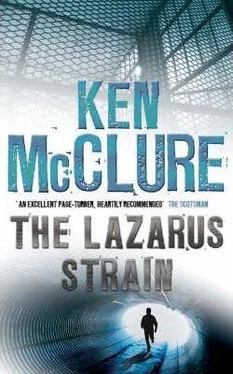Ken McClure
The Lazarus Strain
And thus I clothe my naked villainy
With old odd ends stolen out of holy writ;
And seem a saint, when most I play the devil.
William Shakespeare 1564-1616 (King Richard III)
In 1918 up to forty million people died of a disease that circled the globe — more than died in the Great War itself and more than died of bubonic plague in the epidemic that swept across Europe in the 14 century. They died of a particularly virulent form of pneumonia, which caused their lungs to fill with blood and mucous until they could no longer breathe and effectively drowned in their own secretions. In the United States, the disease affected so many people — one quarter of the entire population — that in certain areas there was a shortage of coffins and gravediggers. Panic was such that travel between certain towns and cities was banned without certified permission. The epidemic alone was responsible for lowering the average life expectancy in the USA by ten years. The disease was influenza.
I had a little bird,
Its name was Enza.
I opened the window,
And in-flu-Enza
Children’s skipping rhyme from the time.
It is estimated that one fifth of the world’s population was affected by the influenza pandemic of 1918–1919, its spread mediated by troops returning home from the war in Europe. Of those American soldiers who fell in Europe, half their number succumbed to influenza rather than enemy fire.
The great influenza pandemic is now beyond living memory to all but a handful of the world’s population but the disease itself is as familiar as the common cold. In fact, the two viruses are often confused — particularly by those seeking to excuse their absence from work — flu sounds just a little more serious than a cold.
Influenza breaks out every winter but is not considered a deadly disease — except perhaps for the very frail or very old — but it still retains the potential to wreak havoc as it did nearly a century ago. The flu virus is a master of disguise, constantly changing the structure of its protein coat and challenging the human immune system in being the equivalent of a moving target. These almost annual changes lead to a situation where the virus will be more virulent in some years than in others — 1957 and 1968 were particularly ‘bad’ years although both pale into insignificance when compared to the ravages of the 1918 strain.
In recent times it has been possible for scientists to study and ‘reconstruct’ the pandemic strain from biological material recovered from the preserved tissue of dead American soldiers who died of flu after returning from the First World War. The wisdom of doing this has been questioned in some quarters and although the scientists concerned claim that such studies will help them to understand the virus better, there are those who suggest that creating a monster in order to understand it is irresponsible in the extreme.
There are also arguments over the level of containment necessary for experimentation with such a dangerous virus and unease expressed over the decision of certain workers to downgrade the requirement from BL-4 (the highest level of containment possible — requiring workers to wear full-cover body suits and hoods — to BL-3, a lower grade involving ‘half suits’. The argument against downgrading is simple: if a laboratory worker should contract the disease and take it out of the lab, flu is so infectious that it would spread like wildfire. If the transport systems of 1918 permitted the virus to reach every corner of the globe, how much more convenient would it find travel in the 21 century? Once the genii is out of the bottle, they maintain, global disaster must surely follow.
The existence of the 1918 strain — even if held in secure laboratories — brings the spectre of terrorist threat into the equation. Pandemic flu would be a fearsome weapon in the hands of those whose only motive is the destruction of Western society. A flu pandemic would disrupt the functioning of the entire civilised world.
As with all virus- caused disease, prevention is better than cure. Antiviral drugs are still in their infancy and nowhere near as effective as antibiotics are in the fight against bacteria. Antibiotics are ineffectual against viruses — although misunderstandings about this still arise. People suffering from viral disease are often prescribed antibiotics, leading to the belief that this is to combat the virus. It is not. The antibiotics are given to prevent secondary bacterial infection moving in and causing complications e.g. bronchitis or streptococcal throat infection. When it comes to fighting viral diseases, tender loving care and the antibodies present in the body’s immune system are the only weapons in the human armoury.
It therefore follows that prevention through vaccination — wherever possible — is the best way to tackle viral disease. Vaccination has proved very effective in wiping out killer diseases of the past. Smallpox has been completely eradicated and polio is no longer the scourge it once was. Influenza however, with its ever changing protein coat presents the vaccine designer with special problems. A vaccine effective against last year’s flu virus might well prove useless against this year’s variant. This leads to annual decisions having to be made by medical authorities over which strains to include in the vaccine for the following winter. Best guess science.
These decisions have to be made early in the year because of the long process involved in flu vaccine production. The chosen virus strains (typically three) have to be grown up in fertile chicken eggs — some 90 million of them — over the course of several months before being harvested and processed prior to distribution into injection vials for the immunisation of between 12 and thirty million people. Approximately one week after vaccination, the B-cells and T-cells of the human immune system will be ready to do battle with the flu virus — provided the scientists guessed right.
Whatever the merits of the scientific study of the 1918 strain, one outcome has been to illustrate just how little genetic difference there is between it and the avian flu viruses that have been causing havoc in bird populations in South East Asia in recent years. It has even been suggested that the 1918 virus itself arose from a mutation in a bird flu strain, which enabled it to cross the species barrier. There is little comfort to be gleaned from further research that indicates that there is actually very little in the way of a species barrier to prevent avian strains crossing to human hosts and cases of avian flu in the human population are already being recorded. Many scientists now believe the re-emergence of a pandemic flu strain to be inevitable, a case of when rather than if. They warn that every effort should be put into vaccine design with this in mind.
While scientists may disagree about many things concerned with the flu virus, there is general agreement that time is not on our side. An effective vaccine is the only conceivable defence against the threat of another pandemic — whether it materialise through natural mutation of a human strain, genetic variation of an avian strain or through malicious intent. But the will and the resources to come up with one have to be in place. Flu vaccine production is an expensive, risky business at the best of times and unpopular among the dwindling number of pharmaceutical companies willing to take it on. The commercial risks are great and compliance with the myriad regulations surrounding production very demanding. There can be no guarantee that a ‘1918 strain’, reconstructed specifically for vaccine production, would provide protection against the variant of the virus that finally appears. The slightest of antigenic changes in that virus might render such a vaccine useless.
Читать дальше












